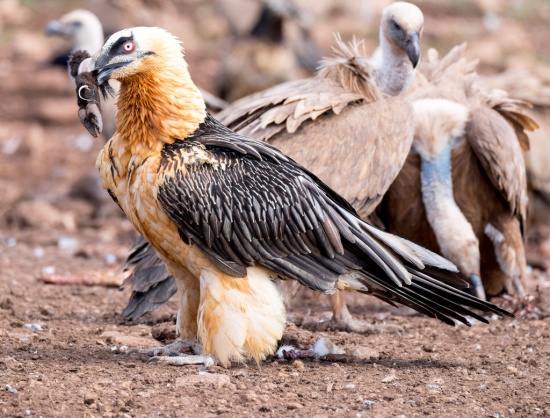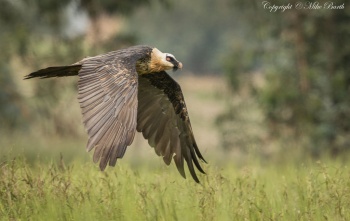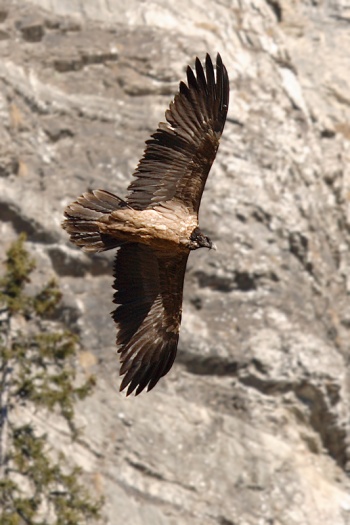Alternative name: Lammergeier

Photo © by Phil Watson
Pyrenees, Spain, 22 March 2016
- Gypaetus barbatus
Identification
Length 105-125 cm (37-49 inches), wingspan 250-282 cm (100-110 inches), weight 4.5-7.1 kg
Adults have a rust-coloured head and underparts, the former with the black moustache which give this species its alternative name. The body feathering is actually white*, but the birds deliberately stain the white feathers rust-coloured by dust-bathing in iron-rich soil. As the availability of iron-rich soil varies from location to location, and the amount of effort individuals put in to dust-bathing also varies, birds vary widely from pale buff to intense orange-red (* as can be seen in a captive bird here with no access to rust). The tail, wings, and back are dark slate-grey.
Juveniles are dark all over with a blackish head and neck, grey underparts and mantle, and blackish wings and tail (pattern reminiscent of a gigantic Hooded Crow); they take five to seven years to reach full maturity, with slow progress toward adult plumage; the head is the last to attain full adult pattern.
Similar species
It is unlike most other vultures in flight, due to its longer, narrower wings tapering toward the primary tips, and long, wedge-shaped tail. Egyptian Vulture is most similar in flight shape, and immatures in particular can be confused where the Bearded Vulture's huge size is not obvious; at long range best told by its relatively shorter tail and less tapered wings.
Distribution
Mountains of Europe, Africa and Asia.
The rarest breeding vulture in Europe, breeding in the Pyrenees, in Greece and the northern Caucasus, and in very small numbers in Corsica and Crete. A reintroduction programme began in the Alps in 1986 with the first breeding in 1997, this population now numbers about 200 and birds are regularly seen in France, Switzerland, Austria and Italy. In 1998 fully wild Lammergeiers successfully bred in the French Pyrenees.
In the Western Palearctic breeds most commonly in Turkey with relict populations in Sinai, possibly also Israel and northern Iraq. Also breeds in the south-west of the Arabian Peninsula and range extends east from the Caucasus across northern Iran to Pakistan, north into Central Asia, the Himalayas, Tibet and north-west and central China.
In Africa breeds in the mountains of Morocco and Algeria, also in eastern Egypt and south to eastern Sudan, Ethiopia and the mountains of Kenya and Tanzania. In southern Africa occurs in Natal, Lesotho, Orange Free State and the far north of Cape Province.
In the Western Palearctic vagrants recorded in Portugal, Germany, Switzerland, the Czech Republic and Slovakia, also Bulgaria and the Ukraine, Cyprus, Syria and Lebanon.
In 1994 a bird from the Alpine reintroduction programme was found on the Atlantic coast of France, in 1998 two were seen in the Netherlands, in 1999 another was recorded in Denmark. In May 2001 an immature was found on the German Baltic island of Rügen, and in 2002-3 there were further Dutch records. Occasionally seen at Gibraltar. In China a vagrant to Hopeh, Shansi and Hupeh.
Taxonomy

Photo © by Alok Tewari
Mahavatar Babaji's Cave, Dist. Almora, Alt 8000+ ft, Uttarakhand Himalayas, India, 2 April 2018
Subspecies
Up to four subspecies have been recognised:
- G. b. barbatus in northwestern Africa
- G. b. aureus in Europe, the Middle East and Asia
- G. b. meridionalis in the Arabian Peninsula, and eastern and southern Africa
- G. b. hemachalanus from eastern Asia
Clements1, IOC2, and HBW3 recognise only G. b. barbatus (north Africa and Eurasia) and G. b. meridionalis (Arabian Peninsula, and eastern and southern Africa), with the other two treated as synonyms of G. b. barbatus2.
A recent phylogeographic and genetic study4, however, indicates that Asian birds are more closely related to eastern and southern-African birds than they are to most European birds. The authors of that study do not feel that it is appropriate to distinguish subspecies.
Habitat
Mountains. In Europe usually at 1,000-2,500m altitude; found in areas with cliffs, deep valleys and high ridges, nests on inaccessible cliffs or small caves, and requires presence of chamois, ibex, wild sheep, or other medium-sized ungulates for carrion. In the Himalayas has been seen above 7,000m. In Ethiopia, has become somewhat commensal with man, taking bones put out for them from abbatoirs; also visits vulture feeding stations in Europe.
Behaviour
Adults constantly rub mud over their chin, breast and leg feathers, giving these areas a rust-coloured appearance.
Diet
Like other vultures it is a scavenger, feeding mostly from carcasses of dead animals. It usually disdains the rotting meat, however, and lives on a diet that is 90% bone and bone marrow. It will drop large bones from a height to crack them to get smaller pieces. Its old name of 'ossifrage' ("bone-crusher") relates to this habit. Live tortoises are also dropped in similar fashion to crack them open.
Breeding
It breeds on crags in high mountains in southern Europe, Africa, India and Tibet, laying one or two eggs in mid-winter which hatch at the beginning of spring. They breed from mid December to mid February, laying one to two eggs, which hatch between 53 and 58 days. Only one chick survives, spending 106 to 130 days in the nest, before flying out on their own, and taking up to 7 years to master the art of bone breaking.
Vocalisation
Bearded Vultures are silent apart from shrill whistles at the breeding crags.
Movements
Adults are strictly resident and, while immatures may wander, they very rarely leave mountain areas.
References
- Clements, J. F., T. S. Schulenberg, M. J. Iliff, D. Roberson, T. A. Fredericks, B. L. Sullivan, and C. L. Wood. 2017. The eBird/Clements checklist of birds of the world: v2017, with updates to August 2017. Downloaded from http://www.birds.cornell.edu/clementschecklist/download/
- Gill, F and D Donsker (Eds). 2016. IOC World Bird Names (version 6.4). Available at http://www.worldbirdnames.org/.
- Del Hoyo, J, A Elliot, and J Sargatal, eds. 1994. Handbook of the Birds of the World. Volume 2: New World Vultures to Guineafowl. Barcelona: Lynx Edicions. ISBN 978-8487334153
- Godoy, J. A., Negro, J. J., Hiraldo, F., & Donazar, J. A. (2004). Phylogeography, genetic structure and diversity in the endangered bearded vulture (Gypaetus barbatus, L.) as revealed by mitochondrial DNA. Molecular Ecology 13: 371-390.
Recommended Citation
- BirdForum Opus contributors. (2024) Bearded Vulture. In: BirdForum, the forum for wild birds and birding. Retrieved 19 April 2024 from https://www.birdforum.net/opus/Bearded_Vulture
External Links
Search the Gallery using the scientific name:
Search the Gallery using Bearded Vulture:
Search the Gallery using Lammergeier:
GSearch checked for 2020 platform.





